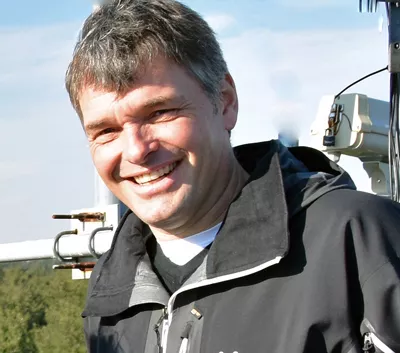
Spruced Up
The field of tree genomics has blossomed over the past few years, and UTM professor Ingo Ensminger from the Department of Biology has significantly contributed to this growing branch of research.
With an Ontario Genomics-funded project led by Ensminger and his collaborator Dr. Nathalie Isabel from the Forest and Environmental Genomics group of the Canadian Forest Service (CFS) in Quebec City, and in association with their industry partner PrecisionHawk, they are working on a suite of modern genomic resources to improve tree breeding and selection.
For this project, Ensminger and his collaborators will use large white spruce progeny trials established in Quebec and Ontario by CFS. This progeny data represents 20 years of tree-breeding research, where scientists from CFS have selected 2000 different genetic lines of spruce seedlings, and they expect to find spruce seedlings among those lines that will efficiently adapt to environmental stresses.
Ensminger and his team will use a drone carrying optical sensors for leaf-spectral measurements and this will help distinguish the best genetic lines based on their “optical fingerprint.”
“The main idea behind the optical fingerprint is the fact that plants constantly interact with their ever changing environment,” says Ensminger.
“This involves adjustments in pigments that are responsible for the color of the leaf. These adjustments take place within minutes and over the course of the season in order to mitigate stress and maximize the yield of photosynthesis, and therefore adjustments in leaf pigments accurately reflect the fitness of a plant.”
Ensminger’s team will use samples of seedlings from the ground and assess their fitness using existing tests. They can then measure their leaf optical properties directly on the ground, and then compare the data from individual seedlings with the leaf-optical data, captured in a fraction of the time and at a much larger scale, by incorporating the drone; the ground data will essentially help them to better understand the drone data and to calibrate their growth models accordingly.
“The resolution of the drone sensor will be good enough to distinguish individual seedlings,” says Ensminger. “Therefore we think we can assess performance of individual plants and quickly identify the most robust genetic lines during a short drone flight from fields with several thousand individuals.”
The investment by Ontario Genomics’ Pre-Commercialization Business Development Fund (PBDF) will support rapid deployment of a software application created by PrecisionHawk that will eventually become available to breeders and forest managers through the Algorithm Marketplace.
“This will be a software tool made for users in the breeding and forest management industry,” says Ensminger.
“They are not specialists in remote sensing and plant physiology, but the software helps them to analyze drone data and to determine the fitness of individual trees or entire forest stands, and to quickly assess when they are water stressed or when the growing season ends, so they can adjust their management practices accordingly.”
Please see the Ontario Genomics site for further information.
